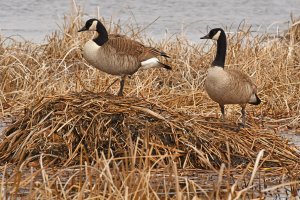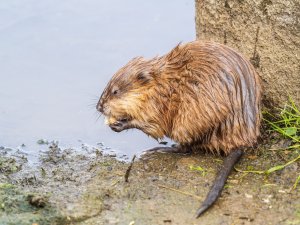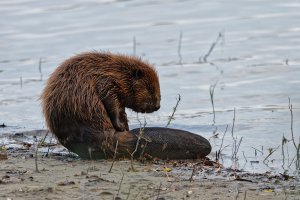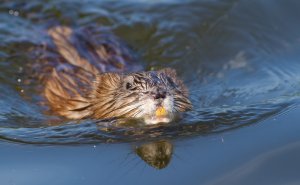In the Cattails: Muskrats
June 14, 2023
By Annica Brocker, Park Interpreter
Along the shore of a lake, by the banks of a river, or in the midst of a marsh in Southeast Michigan, tall cattails grow in large stands. Sprinkled amongst the stands, you might spot mounds made of cattails. Sometimes a goose, swan, or duck might even be nesting on these mounds. Despite using these mysterious mounds, waterfowl have nothing to do with their creation. Neither were these mounds formed by the wind or animals moving through and pushing weaker cattails down. These mounds are muskrat made!

Muskrats are semiaquatic rodents found in wetlands and are native to North America. Muskrats are often confused with North American beavers. However, muskrats are much smaller than beavers, weighing only 1.3 to 4.4 pounds compared to a beaver’s 24 to 71 pounds. In addition to their difference in size, looking at a muskrat and beaver’s tails can also help distinguish the two from each other. A beaver has a large paddle-like tail that runs horizontal to their body, whereas a muskrat has a thin, flat tail that runs vertical to their body. If you still are not convinced based on appearances that muskrats are not just mini beavers with strange tails, hopefully genetics can sway you! Muskrats are actually part of the Cricetidae family of rodents which includes rats and mice but not beavers.


A side-by-side comparison of a muskrat and a North American beaver.
Muskrats, like all rodents, have ever-growing, self-sharpening teeth. The reason rodent teeth are typically orange or yellow is due to their magnesium-dense enamel that only covers the front of their incisors, or front-most teeth. The back of their incisors is softer dentine. As the hardened enamel slices against the soft dentine, the edge of their incisors become honed to a chisel-like edge, capable of gnawing through plants, plastic, and even wires. For muskrats, they employ their incisors to chew through their food of choice: woody vegetation, shoots, cattails and more. Their food of choice often becomes their home building materials along with mud to create their mound-like lodges.

Muskrats have long been a food source for people in the Great Lakes Region. Indigenous tribes historically would use a variety of strategies to hunt muskrats. Some would set traps or nets to catch the muskrats. Others would hunt along waterways or scare the muskrats out of burrows while their companions would be waiting with spears or bow and arrow at the ready. Europeans also relied on muskrat upon their arrival to Michigan. During the height of the French Fur Trade, the Catholic Pope decreed muskrat was permissible to eat on Fridays (a day when no meat except fish was to be eaten) during the season of Lent, since it lives in the water and swims like a fish.
While some believe them to be a nuisance, muskrats have very important ecological roles. Muskrats help in the maintenance of wetlands, and open up waterways as they eat their way through the vegetation. Through their maintenance, muskrats allow a greater diversity of animals to settle into the wetlands. Many other animals such as the waterfowl discussed previously, snakes, turtles, and frogs use muskrat lodges to nest and rest in. Although they have a vegetation heavy diet, muskrats will also eat clams and have been found to eat the highly invasive zebra mussels.
Next time you are near some wetlands, keep an eye out for the sleek bodied muskrats gliding through the water or rustling through the cattails!
